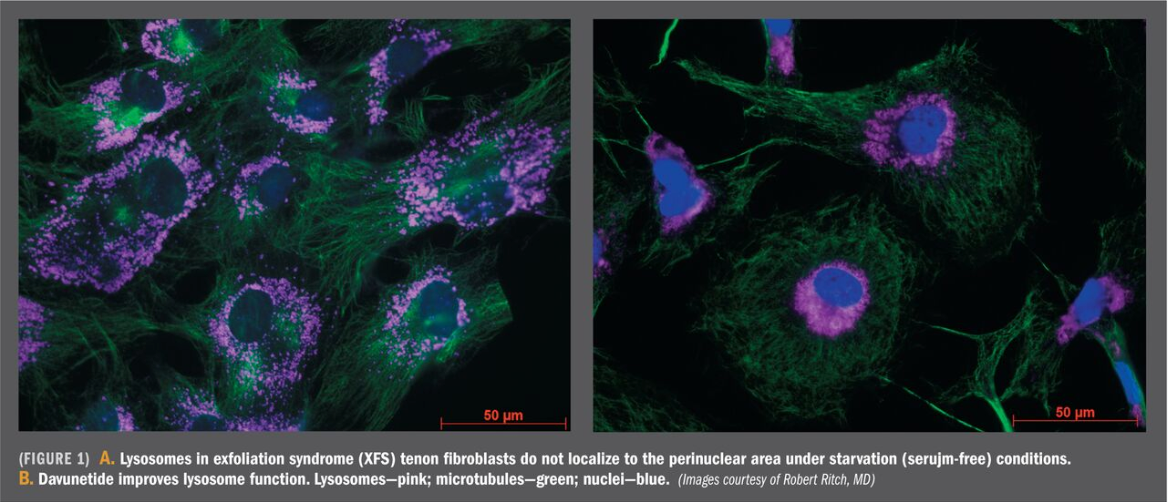Article
Exfoliation syndrome insights
Author(s):
Research to understand underlying mechanisms may lead to clues for targeted therapy

Elucidation of the mechanisms leading to the development of exfoliation syndrome hold the key to non-IOP-lowering interventions that might prevent or reverse disease.
Reviewed by Robert Ritch, MD
Elucidation of the pathophysiology and genetics of exfoliation syndrome (XFS) may lead to the development of targeted therapy for this protean disorder with the potential to prevent, reverse, or even cure about 20% of glaucoma globally, said Robert Ritch, MD.
“Exfoliation syndrome is a systemic disorder of extracellular matrices (ECMs) that was first described 100 years ago, but its importance was largely ignored for the first 90 of those years,” said Dr. Ritch, Shelley and Steven Einhorn Distinguished Chair at New York Eye and Ear Infirmary of Mount Sinai, New York, NY.
Glaucoma is an ocular manifestation of this systemic disease with distinct genetic, biomechanical, cellular, and pathophysiologic mechanisms leading to dysfunction of the trabecular meshwork, according to Dr. Ritch.
“By understanding these mechanisms, we could potentially identify non-IOP-lowering treatment modalities that are applicable at various steps of disease development,” he said.
Current knowledge
To date, two single nucleotide polymorphisms (SNPs) in exon 1 of the LOXL1 gene have been associated with XFS and are thought to be present in up to 99% of affected Caucasians. On the flipside, however, not all people with the LOXL1 SNPs manifest XFS (at least in the eye).
“LOXL1 is a member of the family of lysyl oxidase enzymes that catalyze crosslinking of elastin and collagen, and they are essential for the formation and maintenance of elastic fibers and extracellular matrix homeostasis,” Dr. Ritch explained.
In addition, a genome-wide association study conducted in Singapore has discovered six additional genes associated with XFS and one rare allele that protects against its development.
An infectious origin has been postulated This idea stems from the finding that younger people who undergo penetrating keratoplasty using graft tissue from an older donor can develop XFS earlier than its typical onset. The suggestion has also been made that XFS may be a slow prion disorder.
First insights on the cellular mechanism underlying XFS are available from a study conducted by Dr. Ritch and colleagues Andrew Want, PhD, Audrey Bernstein, PhD, and J. Mario Wolosin, PhD. Comparing tenon fibroblasts from patients with XFS with those from age-matched patients with primary open-angle glaucoma (POAG) or who had undergone strabismus surgery, the researchers suggested that XFS is a disease of dysfunctional autophagy.
“Normally, intracellular lysosomes travel on microtubules to the perinuclear area where their contents are degraded,” Dr. Ritch said.
“In XFS, however, the microtubule organizing center is mislocalized such that lysosomes congregate at the cell periphery, apparently due to abnormal binding to microtubules, and mitochondria are depolarized.”
The decreased clearance of autophagosomes and a decreased ability to degrade misfolded proteins and aging organelles may underlie the development of extracellular protein aggregates in XFS, he added.
Dr. Ritch and colleagues also found that treatment with davunetide, a peptide that is being investigated in clinical trials for the management of various neurodegenerative diseases, stabilized the microtubules and allowed lysosomes to move to the perinuclear area.
“Perhaps davunetide may also be a therapeutic option for XFS and one that could stop the pathophysiologic pathway leading to glaucoma,” Dr. Ritch said.
Ocular and systemic associations
While open-angle glaucoma is the most common ocular manifestation of XFS, this systemic disease has several other ocular associations. They include angle-closure, cataract, zonulopathy, tear film disturbances, keratopathy, posterior synechiae, iris sphincter fibrosis, macular degeneration, and retinal vein occlusion.
XFS is also associated with ischemia, impaired endothelial function, and impaired systemic vascular regulation, and a long list of associated systemic diseases, including cerebrovascular and cardiovascular diseases as well as hearing loss, cognitive dysfunction, pelvic organ prolapse, inguinal hernia, and chronic obstructive pulmonary disease (COPD).
“More research is needed to understand the biologic basis for these associations,” Dr. Ritch said. “One finding of particular interest is that hyperhomocysteinuremia is present in more than twothirds of patients with XFS and is a feature of many of the systemic diseases that are associated with XFS.”
Despite its systemic disease associations, XFS was not found to be associated with an increased risk for mortality according to several papers, he said.
“Interestingly, as well, although people with XFS are at increased risk for developing COPD, patients with both diseases live longer than those with COPD but not XFS,” Dr. Ritch concluded.
Disclosures:
Robert Ritch, MD
E: ritchmd@earthlink.net
This article was adapted from Dr. Ritch’s presentation during Glaucoma Subspecialty Day at the 2018 meeting of the American Academy of Ophthalmology. Dr. Ritch did not indicate any proprietary interest in the subject matter.




